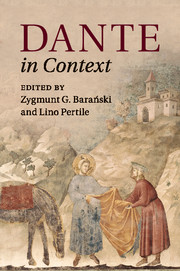Book contents
- Frontmatter
- Dedication
- Contents
- List of illustrations
- List of maps
- Notes on contributors
- Chronology
- Abbreviations and note on translations
- Introduction
- Part I Politics and society
- 1 Empire, Italy, and Florence
- 2 Economy
- 3 Law
- 4 Justice
- 5 Men and women
- 6 Church and orthodoxy
- 7 Heresy and dissidence
- 8 Daily life
- Part II Intellectual traditions
- Part III Linguistic and literary cultures
- Part IV Visual and performative culture
- Part V Dante: life, works, and reception
- Further reading
- Index
5 - Men and women
from Part I - Politics and society
Published online by Cambridge University Press: 05 October 2015
- Frontmatter
- Dedication
- Contents
- List of illustrations
- List of maps
- Notes on contributors
- Chronology
- Abbreviations and note on translations
- Introduction
- Part I Politics and society
- 1 Empire, Italy, and Florence
- 2 Economy
- 3 Law
- 4 Justice
- 5 Men and women
- 6 Church and orthodoxy
- 7 Heresy and dissidence
- 8 Daily life
- Part II Intellectual traditions
- Part III Linguistic and literary cultures
- Part IV Visual and performative culture
- Part V Dante: life, works, and reception
- Further reading
- Index
Summary
At roughly the same time that Dante Alighieri was composing his Commedia, his fellow Florentine poet, Francesco da Barberino (1264–1338) was writing a rather different type of book. His Reggimento e costumi di donna (Conduct and Customs of Women, c.1318–20), written partly in verse and partly in prose, imagined dialogues between real women at various stages in their life cycles, interspersed with advice from allegorical virtues such as Patience and Chastity. Francesco classified women according to their marital and religious identity: maiden, wife, widow, nun, hermit, or servant. Within each of these categories he subdivided according to social class, expending the least energy on working and working-class women. By inscribing the female life cycle according to marital status, he embraced the standard medieval ideology, following the patriarchy of Aristotle's Politics and the pseudo-Aristotelian Economics among others, which dictated that, given the female's inherent weaknesses, the best place for women was the home, under the close tutelage and guardianship of fathers and husbands.
In many ways law statutes promulgated in the emergent communes of the twelfth and thirteenth centuries in northern and central Italy reflected this familial patriarchy. Women were not defined as citizens, suggesting that they played no defined role in political life. Only in feudal Naples did the fourteenth century witness female rule, in the much-maligned person of Giovanna I of Anjou (1325–82; reign 1343–81). Inheritance laws in most city-states limited a woman's inheritance to her dowry portion, demonstrating that money, like politics, was best left in the hands of men. Furthermore, in many places a woman required male oversight to enter into legal agreements. Francesco da Barberino's text, directed at a female audience, presents an idealized summation of the gendered separate sphere ideal that situated men as leaders in both the State and the home, while constraining women's public and private lives. Nonetheless, in the fourteenth century the vicissitudes of daily life meant that some women fulfilled the roles Francesco ascribed to them while engaging in activities well beyond the gendered expectations of prescriptive literature.
Treatises such as Francesco da Barberino's combined advice on how women should fulfil their limited sphere of activities with moral instruction. A well-off wife's duties, beyond swearing to love and be loyal and faithful to her spouse, and possessing unimpeachable virtue, included regulating the house and servants, and maintaining her husband's belongings.
- Type
- Chapter
- Information
- Dante in Context , pp. 71 - 82Publisher: Cambridge University PressPrint publication year: 2015
- 1
- Cited by

